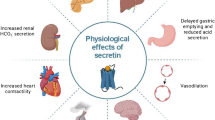Abstract
In several species, bicarbonate and calcium concentrations of pancreatic juice are know to vary during the different phases of pancreatic secretion. The effects of these variations on the saturation of juice with calcium carbonate, a critical factor for the formation of pancreatic stones, are not known. In this work, we studied the saturation degree of pancreatic juice with calcium carbonate in six unanesthetized beagle dogs equipped with Thomas cannulae during basal secretion and after bolus injections of cerulein (30 ng/kg) or secretin (0.25 units/kg). In the different samples of pure pancreatic juice, pH,\(P_{CO_2 } \), bicarbonate, and proteins were measured by standard methods. Total calcium (CaT) and ionized calcium (Ca2+) were determined using calcium-specific electrodes. Saturation with calcium carbonate was calculated by reference to the solubility product of calcite at 37° C. Almost all the samples were found to be supersaturated with calcium carbonate but large variations of the saturation index were observed. In basal samples, obtained during periods of low secretion rate, the mean saturation index (3.35±3.01) was significantly lower than under secretin (12.10±5.14) or cerulein (18.01±8.42). This low basal saturation index, in spite of a high Ca2+ content, was explained by a low bicarbonate concentration (37.6±18.9 mmol/liter) and a high\(P_{CO_2 } \) (13.4±7.5 kPa). In contrast, in juice obtained after hormonal stimulation,\(P_{CO_2 } \) (4.8±1.6 kPa) was similar to plasma\(P_{CO_2 } \) (5.5±1.2 kPa). A high\(P_{CO_2 } \) and low HCO3 − concentration in basal juice are consistent with an intraductal protonation of bicarbonate. These results suggest that, when the residence time of the juice within the ducts increases, H+ ductal secretion, in addition to the previously established HCO3 − resorption contributes to decrease the risk of pancreatic stone formation. In spite of this protective action of pancreatic ducts, however, the stored pancreatic juice remained thermodynamically at risk to precipitation of calcium stones.
Similar content being viewed by others
References
Moore EW, Verine HJ: Pathogenesis of pancreatic and biliary CaCO3 lithiasis: The solubility product (K'SP) of calcite determined with the Ca++ electrode. J Lab Clin Med 106:611–618, 1985
Moore EW, Verine HJ: Pancreatic calcification and stone formation: A thermodynamic model of calcium in pancreatic juice. Am J Physiol 252:G707-G718, 1987
Marteau C, Sastre B, Portugal H, Pauli AM, Gerolami A: Regulation in human gallbladder bile: Study in patients with and without gallstones. Hepatology 11:997–1002, 1990
Rege RV, Moore EW: Pathogenesis of calcium containing gallstones. Canine ductular bile, but not gallbladder bile is supersaturated with calcium carbonate. J Clin Invest 77:21–26, 1986
De Caro A, Multigner L, Dagorn JC, Sarles H: The human pancreatic stone protein. Biochimie 70:1209–1214, 1988
Gerolami A, Marteau C, Matteo A, Sahel J, Portugal H, Pauli AM, Pastor J, Sarles H: Calcium carbonate saturation in human pancreatic juice: Possible role of a ductal H+ secretion. Gastroenterology 96:881–884, 1989
Moore EW, Zimmerman MJ: Pancreatic ionized and total calcium: A test of the thermodynamic calcium model for pancreatic lithogenicity. Gastroenterology 82:1134, 1982 (abstract)
Itoh Z, Takahashi I, Nakaya M, Suzuki T: Variation in canine exocrine pancreatic secretory activity during the interdigestive state. Am J Physiol 241:G98-G103, 1981
Keane FB, Dimagno EP, Dozois RR, Go VLW: Relationships among canine inter-digestive exocrine pancreatic and biliary flow, duodenal motor activity, plasma pancreatic polypeptide and motilin. Gastroenterology 78:310–316 1980
Konturek SJ, Thor PS, Bilski J, Bielanski W, Laskiewicz J: Relationships between duodenal motility and pancreatic secretion in fasted and fed dogs. Am J Physiol 250:G570-G574, 1986
Debas MT, Grossman MI: Pure cholecystokinin: Pancreatic protein and bicarbonate response. Digestion 9:496–481, 1973
Thomas JE: An improved cannula for gastric and intestinal fistulas. Proc Soc Exp Biol Med 46:260–261, 1941
Scott BV, Collignon WG, Bugel HJ, Johnson GC: Relation of external pancreatic secretion to variations in blood sugar. Am J Physiol 134:208–218, 1978
Skeggs LT, Hochstrasser H: Multiple automated sequential analysis. Clin Chim 10:918–936, 1964
Noel-Jorand MC, Colomb E, Astier JP, Sarles H: Persisting modifications of dogs basal exocrine pancreatic secretion after repeated intravenous calcium injections. Eur J Clin Invest 11:249–256, 1981
Moore EW: The role of calcium in the pathogenesis of gallstones: Ca++ electrode studies of model bile salt solutions and other biologic systems with an hypothesis on structural requirements for Ca++ binding to proteins and bile acids. Hepatology 4:228S-243S, 1984
Case RM, Harper AA, Scratcherd T: The secretion of electrolytes and enzymes by the pancreas of the anaesthetized cat. J Physiol 201:335–348, 1969
Case RM, Argent BE: Bicarbonate secretion by pancreatic duct cells: Mechanisms and control.In The Exocrine Pancreas, Biology, Pathobiology and Diseases. VLW Go, JD Gardner, FP Brooks, E LeGenthal, EP DiMagno, GA Scheele (eds) New York, Raven Press, 1986, pp 213–243
Rawls JA, Wistrand PJ, Maren TH: Effects of acid-base changes and carbonic anhydrase inhibition on pancreatic secretion. Am J Physiol 205:651–657, 1963
Swanson CH, Solomon AK: Micropuncture analysis of the cellular mechanisms of electrolyte secretion by the in vitro rabbit pancreas. J Gen Physiol 65:22–45, 1975
Rector C, Floyd JR: Sodium, bicarbonate and chloride absorption by the proximal tubule. Am J Physiol 244:F461-F471, 1983
Rege RV, Moore EW. Evidence for H+ secretion by thein vivo canine gallbladder. Gastroenterology 92:281–289, 1987
Stuenkel EL, Machen TE, Williams JA: pH regulatory mechanisms in rat pancreatic ductal cells. Am J Physiol 254:G925-G930, 1988
Goebell H, Steffen C, Bode C: Stimulatory effect of pancreozymin-cholecystokinin on calcium secretion in pancreatic juice of dogs. Gut 13:477–482, 1972
Moore EW, Verine H: Pancreatic calcification. Formation constants of Ca HCO3 + and CaCO3 0 complexes determined with Ca2+ electrode. Am J Physiol 241:G182-G190, 1981
Author information
Authors and Affiliations
Rights and permissions
About this article
Cite this article
Marteau, C., Blanc, G., Devaux, MA. et al. Influence of pancreatic ducts on saturation of juice with calcium carbonate in dogs. Digest Dis Sci 38, 2090–2097 (1993). https://doi.org/10.1007/BF01297090
Received:
Revised:
Accepted:
Issue Date:
DOI: https://doi.org/10.1007/BF01297090




